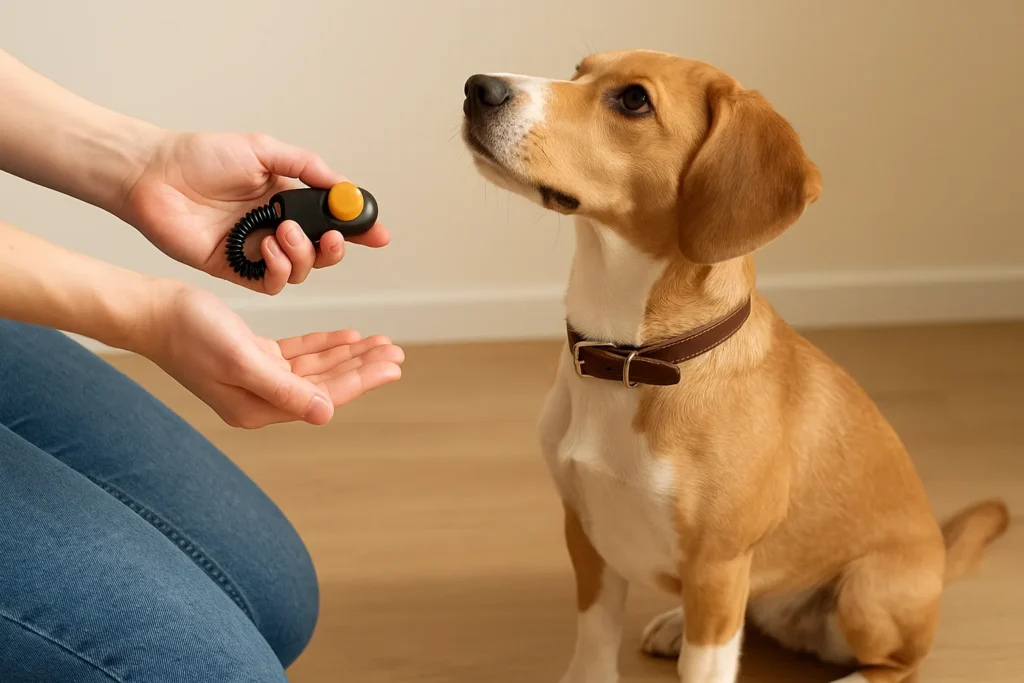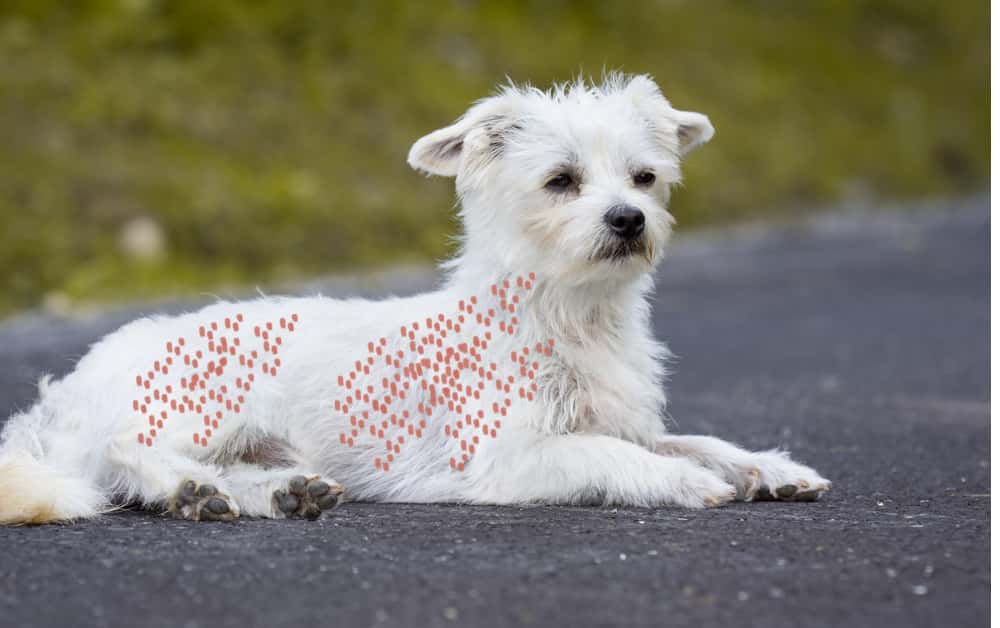Dogs Clicker training has revolutionized the way dog owners communicate and bond with their furry companions. While many people use it to teach basic behaviors like “sit” or “stay,” the real magic happens when you harness it to train complex, advanced commands. Whether you’re working with a family pet, a show dog, or even a service dog, clicker training can become your go-to tool for developing sharp, reliable, and even entertaining behaviors.
Let’s take a deep dive into how you can take your dog’s learning to the next level with clicker training—covering everything from tools and techniques to troubleshooting and success tracking.
What is Dogs Clicker Training?
Dogs Clicker training is a form of positive reinforcement training that uses a small mechanical noisemaker—the clicker—to mark a desired behavior the exact moment it happens. It’s like saying, “Yes, that’s it!” in a language your dog can understand clearly and quickly.
The idea behind clicker training is based on operant conditioning—a psychological principle where behavior is influenced by consequences. When your dog performs a behavior and hears the click, it’s immediately followed by a treat or reward. Over time, the click itself becomes a conditioned reinforcer, meaning your dog will associate that sound with something positive and rewarding.
Why is that little “click” so powerful? It’s consistent, emotionless, and perfectly timed. Your voice might change depending on mood or volume, but a click is always the same—sharp, short, and unmistakable. That helps eliminate confusion and improves your dog’s learning curve dramatically.
Why Clicker Training is Effective
Clicker training stands out from other methods for one main reason: it clearly communicates what behavior is being rewarded. Unlike praise that might be slightly delayed or inconsistent, a click happens right as the behavior occurs. This precision helps your dog link action to reward instantly.
It’s also motivational. Instead of correcting bad behavior, it focuses on reinforcing good behavior, making learning more enjoyable. Your dog isn’t being scared or forced into obedience—they’re learning because it’s rewarding and fun. That means they’ll be more eager to participate and retain what they learn.
Another big perk? It boosts confidence. Dogs that understand what’s expected of them and are frequently rewarded for doing the right thing become more assured and less anxious. This is especially helpful when teaching complex or multi-step behaviors later on.
Foundations of Clicker Training
Tools and Setup Required
Before diving into advanced training, you’ll need a few essentials:
- A Clicker – Choose a basic handheld clicker with a consistent sound. There are even ones that fit on your finger like a ring.
- High-Value Treats – Think tiny, soft, and irresistible. You’ll be giving out a lot of these.
- A Quiet Space – Especially important when you’re just starting out or introducing a new command.
- Leash or Harness – Useful for managing your dog’s movement during lessons.
- Patience and Consistency – These are your mental tools. Don’t leave home without them!
Pro tip: Keep training treats in a pouch or pocket for easy access, and use a leash or barrier to control the environment if your dog gets overly excited or distracted easily.
Conditioning Your Dog to the Clicker
Before teaching any commands, your dog needs to understand what the clicker means. This is called “charging the clicker.” Here’s how to do it:
- Click and Treat: Click the clicker, then immediately give a treat.
- Repeat: Do this 15–20 times in a quiet setting.
- Watch for a Reaction: After several repetitions, your dog should start perking up or looking expectantly when they hear the click—that means they’ve made the connection.
Avoid using the clicker for anything other than marking good behavior. It should never be used to get your dog’s attention or as a noise deterrent. Keep it sacred—like a secret code just for you two.
Reinforcing Basic Obedience
Before advancing to complex behaviors, your dog should be rock-solid on the basics. These commands form the building blocks of more advanced actions. Think of them as the “ABCs of dog training.”
- Sit: Start by luring your dog’s nose up with a treat while gently pushing back on their bottom. The second they sit—click and treat.
- Stay: Ask your dog to sit, hold your hand out like a stop sign, take one step back. If they stay, click and treat. Gradually increase distance and time.
- Come: This one saves lives. Start indoors with short distances. Use a happy voice, say “Come!”, and when they reach you—click and treat.
Revisit these daily. The more automatic these become, the easier it’ll be to layer on advanced skills.
Timing and Consistency in Reinforcement
In clicker training dog, timing is everything. A delayed click is a missed opportunity, and inconsistent rewarding can create confusion. When your dog performs a behavior, click at the exact moment they succeed—not one second later. Then reward immediately.
Let’s say you’re teaching your dog to “shake hands.” The very second their paw touches your hand—click. If you wait until after you give them the treat or while you’re praising them, they might think the reward is for sitting still or wagging their tail.
Train yourself as much as your dog. Practice clicking with your own reactions—test your speed and accuracy. Some trainers even recommend rehearsing with a tennis ball dropping into a cup just to fine-tune your timing.
Transitioning to Advanced Commands
What Qualifies as an Advanced Command?
Advanced commands go beyond the basics and often require a mix of obedience, problem-solving, and sometimes even physical skill. These commands may include:
- Fetching specific objects
- Turning off lights or opening doors
- Walking to heel off-leash
- Performing tricks like spinning or bowing
- Complex service tasks like alerting to sounds or picking up dropped items
These aren’t just for show—they enhance your dog’s mental engagement and can serve real functional purposes, especially for service dogs or therapy animals.
Setting Realistic Training Goals
Jumping straight into teaching your dog to close a drawer with their nose sounds cool—but without a plan, it can be frustrating for both of you. Start with micro-goals:
- Break the command into steps (e.g., go to drawer → touch drawer → nudge drawer → push until closed).
- Reinforce each step with a click and treat before moving on.
- Practice short sessions (5–10 minutes), several times a day.
- Track progress with notes or videos so you can identify what’s working and what needs adjusting.
Also, know your dog’s limits. Some dogs may excel in scent-based tasks, others in physical actions. Work with their strengths and train with love and patience.
Teaching Complex Behaviors with Clicker Training
Step-by-Step for “Heel” Command
Teaching your dog to “heel” is a game-changer, especially if you love going for walks. Instead of pulling on the leash or darting toward every distraction, your dog stays calmly by your side. With clicker training, this command becomes both easy and fun to teach.
Step 1: Start Indoors or in a Quiet Area
Begin in a distraction-free zone. Hold the clicker in one hand and a treat in the other. Walk a few steps and wait for your dog to naturally align beside you.
Step 2: Mark and Reward the Position
The second your dog is walking in the correct position—shoulder next to your leg—click and reward. Repeat this multiple times.
Step 3: Add the Cue “Heel”
Once your dog consistently walks by your side, start adding the verbal cue “heel” just before they reach the position. Click and treat every time they get it right.
Step 4: Increase Distance and Duration
Slowly increase how far you walk before clicking. This teaches your dog to maintain the position for longer periods.
Step 5: Add Distractions
Introduce mild distractions (e.g., people, noises) and reward your dog for staying focused. Gradually increase the challenge level.
Pro tip: Keep your movements smooth and relaxed. Your energy will guide your dog more than you think.
Training Your Dog to “Fetch Specific Items”
Imagine saying “bring me the remote” and your dog actually does it. With clicker training, you can teach your dog to recognize and retrieve specific objects by name.
Step 1: Choose an Object
Start with something simple—like a toy. Let your dog sniff and interact with it. Say its name (“toy”) each time.
Step 2: Shape the Behavior
Click and reward for any interaction with the object—sniffing, touching, nudging. Gradually increase the criteria until your dog picks it up.
Step 3: Add the Cue and Build Association
Once your dog reliably picks up the item, add the verbal cue (“fetch toy”). Click and treat when they do it correctly.
Step 4: Introduce Other Items
Place the original toy next to a different object. Say “fetch toy” and click only when they choose the correct one. This teaches item discrimination.
Step 5: Expand Vocabulary
Once your dog understands a few objects, you can introduce new ones and build a whole command vocabulary!
Use high-value treats here—fetching specific items takes more mental effort, and your dog deserves to feel like a genius for nailing it.
Using Clickers to Teach “Turn Off the Light” or “Close the Door”
This one’s for the doggy overachievers out there—or anyone needing help with household tasks. Teaching your dog to perform tasks like turning off lights or closing doors involves shaping behavior step-by-step.
Step 1: Target Training
Start by teaching your dog to touch a target with their nose or paw. This could be a sticky note, a dot sticker, or your hand.
Step 2: Place the Target on the Object
Put the target on the light switch or door. Click and treat when your dog touches it.
Step 3: Reinforce Pressure Application
For switches, reward only when your dog applies enough pressure to turn off the light. For doors, reward when your dog starts pushing it closed.
Step 4: Add Verbal Cues
Use “turn off” or “close” just before your dog performs the action. Once consistent, start removing the visual target gradually.
Step 5: Generalize the Behavior
Practice in different rooms and with different light switches or doors to reinforce the command universally.
Be patient—this one takes time. But once your pup figures it out, you’ll be amazed at how smart and capable they are.
Incorporating Hand Signals with Clicker Cues
Benefits of Combining Visual and Audio Signals
Using hand signals alongside verbal commands and clicker cues enhances communication, especially in noisy environments or with hearing-impaired dogs. Dogs naturally pay close attention to body language, so hand signals feel intuitive to them.
Why it Works:
- Redundancy improves understanding: Your dog can rely on either the voice or the visual cue.
- Clear communication: Hand gestures are often more distinct than voice commands.
- Better for advanced tricks and distance commands.
Pairing the clicker with hand signals also allows for “silent” training—ideal in environments where verbal commands might be disruptive or ineffective.
How to Phase Out the Clicker Gradually
Eventually, you might want to phase out the clicker once the behavior becomes reliable. Here’s how to do it without confusing your dog:
Step 1: Fade the Clicker, Keep the Treat
Start by reducing how often you click but still offer the treat. For instance, click only every third or fourth correct behavior.
Step 2: Use Verbal Praise as a Bridge
Introduce verbal affirmations like “Yes!” or “Good job!” as a replacement for the clicker. Make sure the tone is always upbeat and consistent.
Step 3: Randomize Rewards
Start rewarding randomly rather than every time. This keeps your dog engaged, much like a slot machine effect. They know a treat might come, so they keep playing.
Step 4: Reinforce Occasionally
Even after full training, offer occasional rewards to keep behaviors strong. Think of it like giving bonuses for continued good performance.
Phasing out doesn’t mean your dog forgets—it means they’ve internalized the behavior and no longer need constant reinforcement.
Troubleshooting and Common Mistakes
Dealing with Frustration and Confusion
Even the smartest dogs (and humans) hit roadblocks. If your dog isn’t progressing, it’s likely due to confusion, lack of motivation, or unclear cues.
Look for These Signs:
- Your dog turns away or walks off during training.
- They perform the wrong behavior repeatedly.
- They seem anxious or frustrated.
Solutions:
- Go back a step: Simplify the task and rebuild confidence.
- Shorten the session: Overtraining leads to fatigue.
- Use higher-value rewards: A little chicken goes a long way.
- Review your timing: A poorly timed click can reinforce the wrong behavior.
Also, take a break if needed. Sometimes a few hours or a good night’s sleep helps everything “click” into place.
Misuse of the Clicker and How to Correct It
Common clicker mistakes can hinder progress:
- Clicking too late: If you click even a second late, your dog might associate the reward with a different behavior.
- Clicking repeatedly: One behavior = one click. Repeating the click confuses your dog.
- Using the clicker as a cue: It’s not a command; it’s a marker. Don’t click to get their attention.
How to Fix It:
- Practice your timing separately.
- Record yourself and review your technique.
- Be intentional—click only for specific actions, not just “good effort.”
Reset if needed. If your dog’s gotten confused, take a step back, recondition the clicker, and restart with a behavior they already know.
Keeping Training Sessions Fun and Productive
How Long Should a Session Be?
Just like humans, dogs can burn out if learning sessions go on too long. And a tired, distracted dog won’t absorb much. The ideal clicker training session is short, focused, and packed with fun.
Best Practices for Session Timing:
- Young puppies: 3–5 minutes max. Their attention spans are tiny.
- Adult dogs: 5–10 minute sessions are optimal.
- Advanced learners: You can stretch it to 15 minutes, but only if your dog stays engaged.
Rather than one long session, aim for multiple short sessions throughout the day. For example:
- Morning before a walk
- Afternoon play break
- Evening calm training
You can also integrate training into daily routines. For instance, ask for a trick before meals or during TV commercials. These micro-sessions compound quickly and make learning natural.
Watch your dog’s signals. If they start sniffing, yawning, or turning away—end the session on a high note with an easy win and a reward. That way, they’ll be excited for the next session.
Creative Ways to Keep Your Dog Engaged
Variety is the spice of training. Even the most obedient dog will get bored doing the same command over and over. The key? Mix it up.
Fun Ways to Keep Things Fresh:
- Switch environments: Train in the kitchen today, the backyard tomorrow.
- Use toys as rewards: Some dogs go wild for a tug toy or fetch game instead of treats.
- Play training games: Try “find it” games with objects or hide-and-seek.
- Teach a silly trick: High-fives, spins, or “play dead” break the routine.
- Rotate commands: Instead of hammering “heel” for 10 minutes, switch between 3–4 behaviors.
Engagement starts with you. Be animated, celebrate successes with praise, and treat training like a shared adventure—not a chore.
Real-Life Applications of Advanced Commands
Service Dog Training and Clicker Use
Clicker training isn’t just for hobbyists—it’s a cornerstone of service dog programs around the world. Why? Because it builds precision, consistency, and reliability—all essential traits in a working dog.
Common Service Dog Tasks Taught with Clickers:
- Retrieving medication or alerting to medical emergencies
- Guiding handlers around obstacles
- Opening or closing doors
- Interrupting harmful behaviors (e.g., PTSD episodes)
Training a service dog takes months (sometimes years), and clicker training plays a massive role in shaping behaviors step-by-step.
What sets service dogs apart isn’t magic—it’s structure, patience, and methodical clicker training. That same system can work for any dog learning advanced skills at home.
Improving Your Dog’s Problem-Solving Skills
Clicker training encourages dogs to think independently and problem-solve, especially when you’re shaping new or unfamiliar behaviors. It teaches them that offering new actions can result in rewards—a powerful motivator.
How to Boost Cognitive Engagement:
- Shape new behaviors without giving too many hints. Let them experiment!
- Use puzzle toys and click when they solve them.
- Add variations to known commands—like different objects or scenarios.
Example: If your dog knows “sit,” try asking for it on a raised surface or different flooring. This forces them to process the command, not just react automatically.
Think of clicker training as your dog’s brain gym. Every session is a workout that improves focus, resilience, and confidence.
Tracking Progress and Celebrating Success
Using a Training Journal
Consistency is key—and tracking progress helps you stay on course. A training journal gives you a big-picture view of what’s working and what needs a tweak.
What to Record:
- Date/time of sessions
- Commands practiced
- Success/failure rates
- Treat types used
- Any distractions or issues
This data helps you spot patterns. For example, maybe your dog nails “heel” in the morning but struggles in the evening—indicating timing matters. Or perhaps they do better with chicken than kibble—great to know!
Apps like Pupford or simple pen-and-paper logs work great. What matters most is consistency and detail.
Knowing When to Level Up
One of the most exciting parts of clicker training is seeing your dog “get it.” But how do you know when it’s time to raise the bar?
Signs Your Dog is Ready:
- Responds correctly 80–90% of the time
- Performs without the lure or treat
- Can execute the command in different environments
- Maintains behavior even with distractions
Once your dog reaches that level, challenge them with:
- New locations
- Longer durations
- Added distractions
- Chaining commands (e.g., “fetch bottle, bring to me”)
Each “level up” helps solidify the command and builds your dog’s confidence. Just remember: always reward progress, even if it’s small. Growth is growth.
FAQs
Absolutely! While some breeds may pick up new commands faster, every dog can benefit from the clarity and consistency clicker training offers.
If your dog reliably responds to basic commands (sit, stay, come) and can stay focused during sessions, it’s time to level up.
You can start as early as 7–8 weeks old. But it’s never too late—older dogs can learn new tricks too!
Yes, but not for punishment. Instead of correcting bad behavior, use the clicker to reinforce the behaviors you want to see more of.
Treats are crucial in the early stages, but as your dog progresses, you can replace them with praise, play, or intermittent rewards.










![Can Dogs Eat Blood? 7 Side Effects [Expert Opinion]](https://petskor.com/wp-content/uploads/2022/04/Webp.net-resizeimage-12.jpg)
